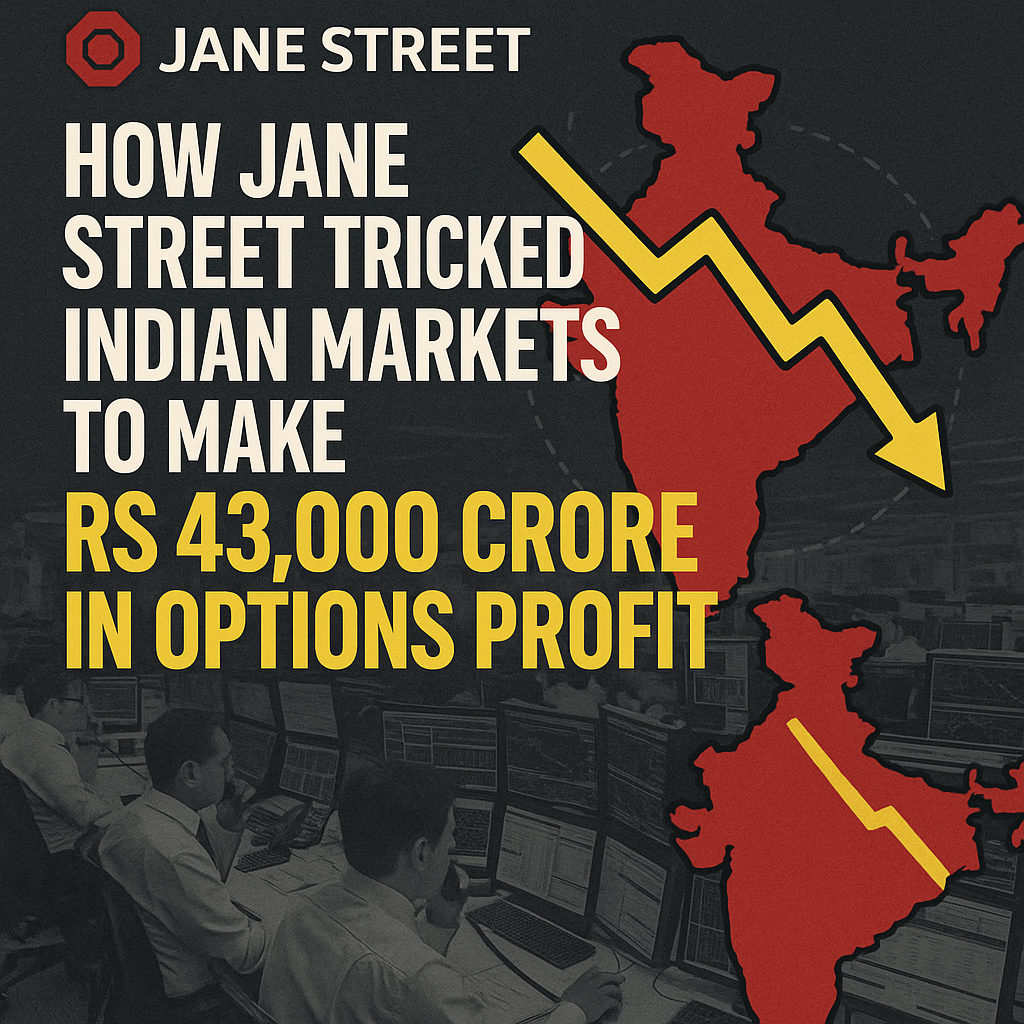
Subtitle: Inside the Strategic Moves of a Global Trading Giant That Rattled Indian Derivatives Markets
Introduction
In one of the most sensational financial stories of the decade, global trading powerhouse Jane Street is reported to have made an astonishing ₹43,000 crore (~$5.2 billion) from the Indian derivatives market, particularly through index options. While this figure alone is enough to turn heads, what has caused an uproar is how the firm accomplished this feat—allegedly by exploiting inefficiencies in India’s rapidly growing, yet often unguarded, financial markets.
This article dives deep into the mechanisms, controversies, and implications surrounding this massive profit, revealing how one of Wall Street’s most secretive trading firms took Indian markets by storm.
Who Is Jane Street?
Founded in 2000, Jane Street is a global proprietary trading firm known for quantitative trading, market making, and arbitrage strategies. With a reputation for secrecy and technological superiority, the firm handles billions of dollars in trades daily across global markets. Its operations span across equities, fixed income, commodities, and—importantly in this case—derivatives.
Understanding the Indian Options Market Boom
India’s stock market has witnessed an explosive rise in options trading, especially with the Nifty and Bank Nifty index options. Retail participation has surged dramatically, fueled by low capital requirements, high return potential, and a booming interest in financial speculation.
According to data from SEBI and NSE:
India now sees the highest number of derivatives contracts traded in the world.
Retail investors often lack institutional-grade tools and strategies.
The market is liquid but inefficient, a ripe opportunity for global traders with better tech.
How Jane Street Allegedly Profited
Jane Street reportedly capitalized on several factors unique to Indian markets:
- Volatility Exploitation
By analyzing minute-by-minute price movements, Jane Street deployed ultra-fast, algorithmic systems to take advantage of volatility in the Indian options market. The firm is said to have used straddle and strangle strategies, coupled with dynamic delta hedging, to profit from retail-driven market swings.
- Cross-Market Arbitrage
Jane Street allegedly engaged in cross-listing arbitrage, comparing derivative pricing in Indian exchanges with global derivatives (like SGX Nifty in Singapore) and executing profitable trades based on temporary mismatches.
- Mispriced Options
India’s options market is often plagued by mispriced premiums due to low institutional participation and retail speculation. Jane Street’s advanced AI-based models allowed them to identify and exploit these mispricings within milliseconds.
- Execution Speed
The firm’s co-location servers—installed close to the NSE trading engine—gave them near-zero latency. This speed advantage meant Jane Street could act on market inefficiencies faster than any local broker or retail investor.
The ₹43,000 Crore Figure – Is It Real?
While NSE and SEBI have not officially confirmed the ₹43,000 crore profit, several credible financial analysts have backed the claim based on:
High-frequency trading activity patterns.
Options chain analytics from January to June 2024.
Trade volume spikes corresponding with institutional algorithmic footprints.
Even conservative estimates suggest tens of thousands of crores in net profits flowing out of India into foreign trading accounts, with Jane Street suspected to be the largest beneficiary.
Regulatory Backlash and Concerns
The staggering profit figure has triggered alarm bells at SEBI (Securities and Exchange Board of India), which has begun reviewing:
Co-location access protocols.
Algo trading regulation loopholes.
Foreign participation rules in index derivatives.
Retail investors and domestic brokers have also voiced concerns over an uneven playing field that favors international giants with superior infrastructure and capital.
Was It Legal or a Loophole?
Jane Street’s strategies, while aggressive, are not illegal under current Indian laws. However, they appear to exploit regulatory blind spots and retail ignorance. Similar controversies have arisen in the past in the U.S. and EU, but regulatory frameworks there are more evolved.
India, on the other hand, is still catching up in monitoring:
Latency arbitrage.
High-frequency order flow.
Institutional “gaming” of market inefficiencies.
Lessons for Indian Markets
This incident is a wake-up call for Indian markets and policymakers:
- Strengthen Regulation
SEBI needs to introduce tighter rules for algorithmic and co-location trading, ensuring no unfair speed advantage. - Educate Retail Investors
The surge in option trading among new retail investors has created fertile ground for institutional exploitation. Education on derivatives risk is crucial. - Level the Infrastructure
Indian brokers must be empowered with better execution tools and fair access to data to compete with global players. - Limit Foreign Algo Access
A review of FPI (Foreign Portfolio Investment) access to high-frequency trading in derivatives could be on the horizon.
Conclusion: A Cautionary Tale
Jane Street’s reported ₹43,000 crore windfall is not just a stunning financial achievement—it’s a story of asymmetry in technology, speed, and knowledge. As Indian markets become more globalized, such episodes may become more frequent unless regulators, brokers, and investors upgrade their systems and understanding.
This saga should not be seen purely as manipulation, but as a glaring reminder of the modern financial battlefield—where algorithms trade at lightning speed, and information is the ultimate weapon.
What Lies Ahead?
As SEBI begins its review, and political pressure mounts to protect Indian investors, we may soon see new rules that curb unchecked algorithmic dominance. Meanwhile, firms like Jane Street will continue to seek alpha wherever inefficiencies exist—be it Wall Street or Dalal Street.
Author: Panu Gujjar
Published: July 2025
Category: Finance | Markets | Derivatives
Leave a Reply